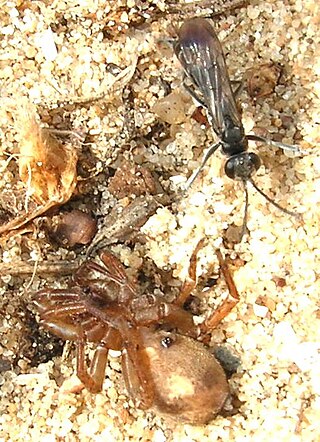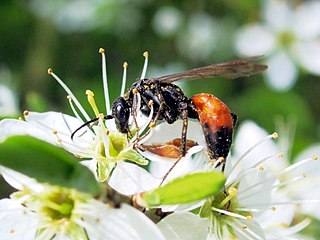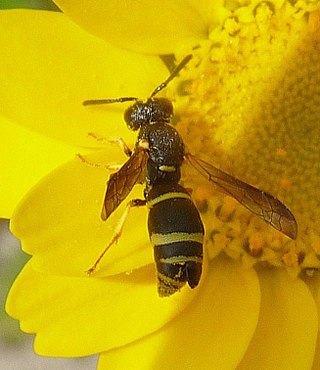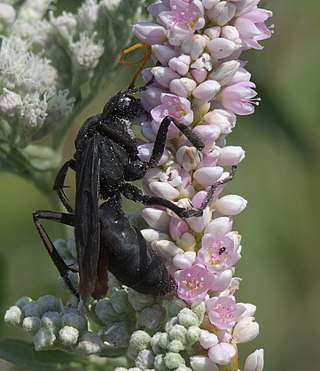
Pompilus cinereus, the leaden spider wasp is the most widespread species of the Pompilus spider wasps, and throughout a large proportion of its wide distribution is the only species of Pompilus. It is the type species of the genus Pompilus and therefore of the family Pompilidae.

Dipogon subintermedius is a spider wasp from the family Pompilidae.

Aporus unicolor, common name cutpurse, is a highly specialised spider hunting wasp from the family Pompilidae.

Priocnemis perturbator is a relatively large species of spider wasp which is quite common in Europe. It was previously considered to be the same species as the closely related P. susterai which were lumped as P. fuscus and this means that some early observations of behaviour are not applicable to either species. Even now the two species need close observation under a microscope or hand lens to distinguish them from each other.

Priocnemis monachus is a species of spider wasp endemic to New Zealand, where it is known as the black hunting wasp or ngaro wīwī. It hunts large tunnelweb or trapdoor spiders, paralysing them with its sting and storing them in burrows for its larvae to eat alive. It is the largest member of the family Pompilidae in New Zealand.
Evagetes crassicornis is a kleptoparasitic spider wasp with a holarctic distribution.
Arachnospila anceps is one of the more common spider wasps of western Europe.

Arachnospila trivialis is a widespread spider wasp of sandy soil areas of the Palaearctic.

Agenioideus cinctellus is a spider wasp of the subfamily Pompilinae with a Palearctic distribution.

Caliadurgus fasciatellus is a species of spider wasp from the subfamily Pepsinae found from Western Europe to the Far East of Asia.

Priocnemis coriacea is a large species of pepsine spider wasp characterised by having plentiful erect hair on the face and propodeum. It is a member of the subgenus Umbripennis.

Anoplius viaticus, commonly known as the black-banded spider wasp, is a species of spider wasp. These wasps are known as spider wasps because the females capture spiders to provide their offspring with food. The paralysed spider is cached in a burrow, the wasp lays an egg on it, and when this hatches, the developing wasp larva consumes the spider. This species is found in sandy heathland across most of Europe.
Anoplius infuscatus is a species of spider wasp found mainly in Eurasia.

The rain spider wasp or red-femora spider wasp is an Afrotropical species of spider wasp specialising in capturing spiders of the genus Palystes, the rain spiders.

Tachypompilus ferrugineus, the rusty spider wasp, red-tailed spider hunter, or sometimes red-tailed spider wasp is a species of spider wasp from the Americas. It preys mainly on wandering spiders, especially wolf spiders.

Trochosa terricola is known as the ground wolf spider, is a wolf spider which is common and widespread in western and central Europe. It has been recorded as prey for the pompilid wasp.

Pepsis grossa is a very large species of pepsine spider wasp from the southern part of North America, south to northern South America. It preys on tarantula spiders, giving rise to the name tarantula hawk for the wasps in the genus Pepsis and the related Hemipepsis. Only the females hunt, so only they are capable of delivering a sting, which is considered the second most painful of any insect sting; scoring 4.0 on the Schmidt sting pain index compared to the bullet ant's 4.0+. It is the state insect of New Mexico. The colour morphs are the xanthic orange-winged form and the melanic black winged form. In northern South America, a third form, known as "lygamorphic", has a dark base to the wings which have dark amber median patches and a pale tip.

Odynerus spinipes, the spiny mason wasp, is a species of potter wasp from western Europe. It is the type species of the genus Odynerus, being first described by Carl Linnaeus in his landmark 1758 10th edition of Systema Naturae.

Pison spinolae, commonly known as mason wasp, is a solitary wasp of the family Crabronidae, found throughout New Zealand.

Entypus fulvicornis is a species of spider wasp belonging to the family Pompilidae. It is found in North America.
















